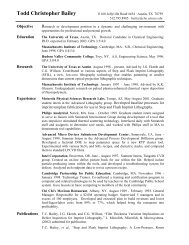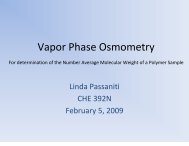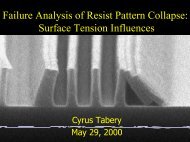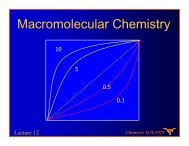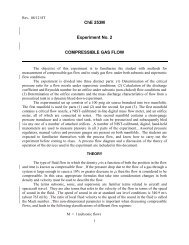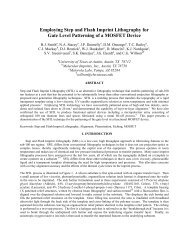Asymmetric fluid-structure dynamics in nanoscale imprint lithography
Asymmetric fluid-structure dynamics in nanoscale imprint lithography
Asymmetric fluid-structure dynamics in nanoscale imprint lithography
- No tags were found...
You also want an ePaper? Increase the reach of your titles
YUMPU automatically turns print PDFs into web optimized ePapers that Google loves.
In the impr<strong>in</strong>t<strong>in</strong>g process, it has been shown that defects due to particlecontam<strong>in</strong>ation can be removed by first us<strong>in</strong>g a sacrificial wafer to perform <strong>in</strong>itialimpr<strong>in</strong>t<strong>in</strong>g to remove the particles. Upon repeated impr<strong>in</strong>t<strong>in</strong>g, particles rema<strong>in</strong> onthe sacrificial wafer. However, for the active stage test bed, there is no currentcapability to perform this impr<strong>in</strong>t<strong>in</strong>g. Thus, it is very difficult to obta<strong>in</strong> particlefreegap between the quartz and substrate.6.5.2 Signal Process<strong>in</strong>gIn the process of collect<strong>in</strong>g gap data, noise or distortion is <strong>in</strong>troduced <strong>in</strong>tothe reflectivity <strong>in</strong>tensity data. Consider that the light received by the spectrometerconsists of three components as follows:where⎛ n ⎞ ⎛ n ⎞R⎜⎟ = I⎜⎟ ∗ S⎝ λ ⎠ ⎝ λ ⎠( λ) ∗ K( t)[6.1]⎛ n ⎞I⎜⎟ is the actual reflectance of the film under consideration. It is a⎝ λ ⎠function of the <strong>in</strong>dex of refraction n and wavelength λ. S ( λ)is a function, whichcharacterizes the wavelength dependence of the optical components of thesystem. K () t is a function that allows for time-dependent <strong>in</strong>tensity variationssuch as changes <strong>in</strong> the illum<strong>in</strong>ation <strong>in</strong>tensity of the light source (<strong>in</strong> this case thetungsten-halogen lamp), sample placement, angle of <strong>in</strong>cidence, focus, etc.In the best-case scenario, S ( λ)and K () t do not conta<strong>in</strong> periodic data.Typically, this can be assumed for S ( λ), s<strong>in</strong>ce spectrometer manufacturersusually design these optical systems tak<strong>in</strong>g this <strong>in</strong>to consideration. However, itwas observed that K () t does conta<strong>in</strong> periodic <strong>in</strong>formation and generates a signal95



